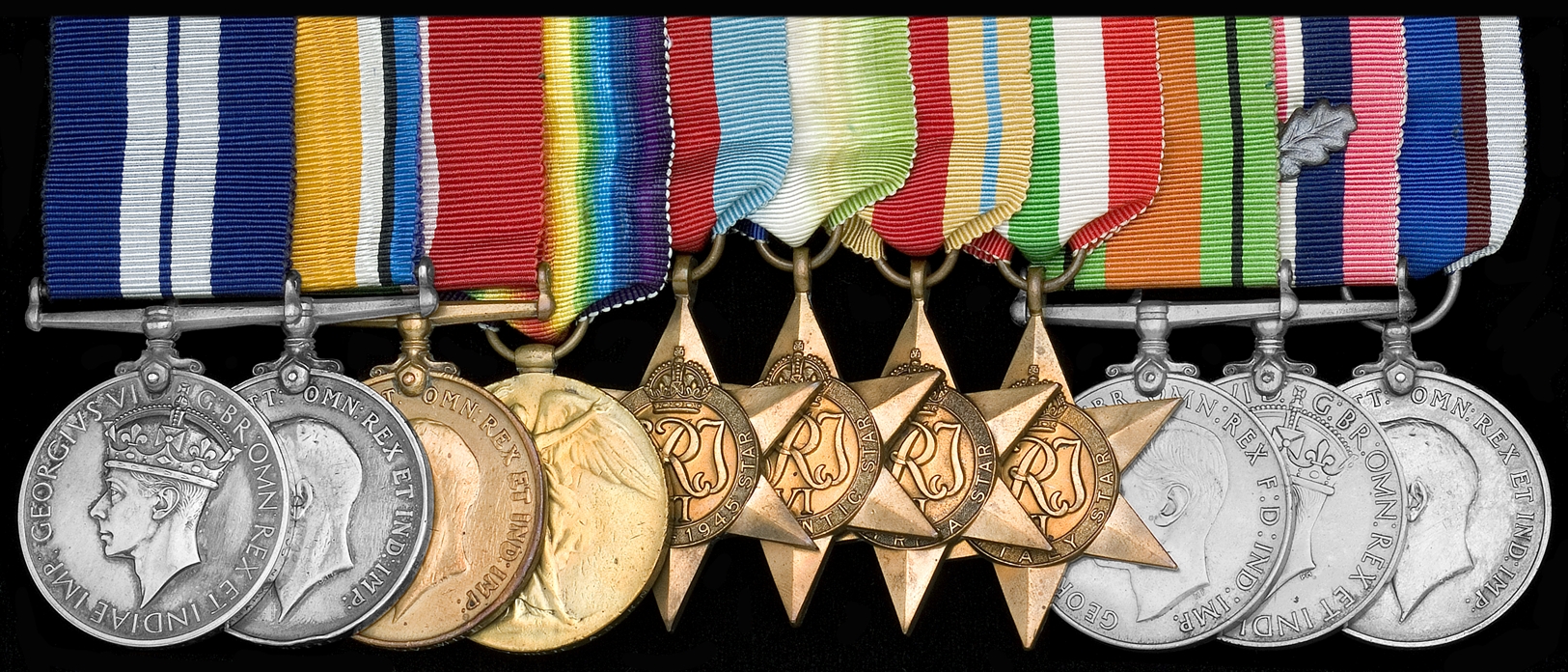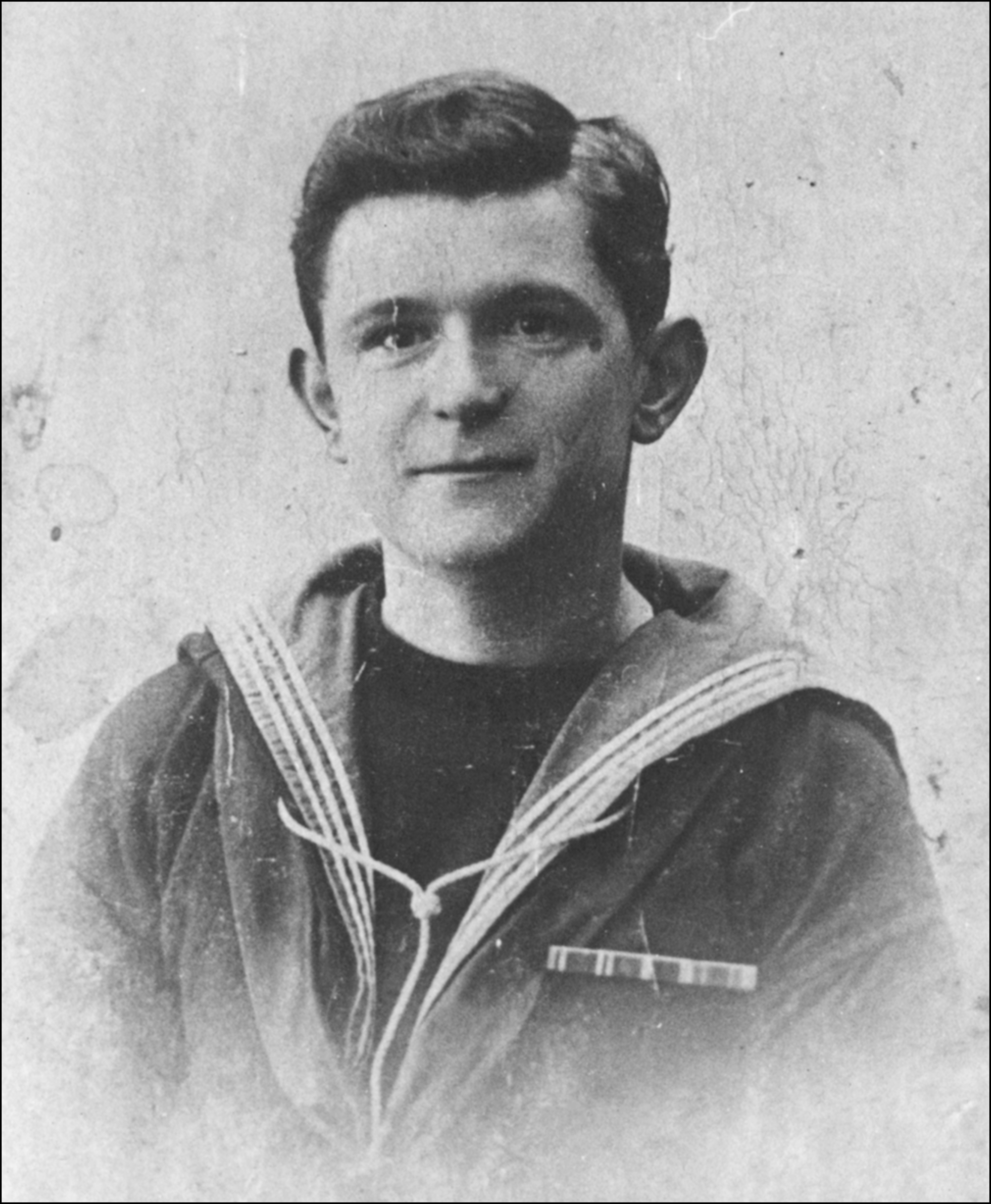A rare Second War armed merchant cruiser operations D.S.M. group of eleven awarded to Leading Seaman L. R. V. White, Royal Fleet Reserve, late Mercantile Marine and Royal Navy, who was decorated for his gallant deeds in the famous South Atlantic clash between the Carnarvon Castle and enemy raider Thor. He was subsequently Mentioned in Despatches for his bravery when L.S.T. 422 was lost in a mine-field during a violent storm off Anzio on 26 January 1944 with the loss of over 450 lives Distinguished Service Medal, G.VI.R. (P.J. 49705 L. R. V. White, L./S., H.M.S. Carnarvon Castle); British War Medal 1914-20 (J. 49705 L. R. V. White, A.B., R.N.); Mercantile Marine War Medal 1914-18 (Leonard R. V. White); Victory Medal 1914-19 (J. 49705 L. R. V. White, A.B., R.N.); 1939-45 Star; Atlantic Star; Africa Star; Italy Star; Defence and War Medals 1939-45, with M.I.D. oak leaf; Royal Fleet Reserve L.S. & G.C., G.V.R., 2nd issue, coinage bust (J. 49705 (PO. B. 17439) L. R. V. White, L.S., R.F.R.) minor official corrections to naming on the first and last, the three Great War awards with edge bruising and polished, thus fine, the remainder good very fine and better (11) £1,800-£2,200 --- Importation Duty This lot is subject to importation duty of 5% on the hammer price unless exported outside the UK --- --- Provenance: Strong Collection, Dix Noonan Webb, May 2011. D.S.M. London Gazette 6 June 1941: ‘For great courage and devotion to duty in action against an armed merchant raider.’ The original recommendation states: ‘On the occasion of the action between H.M.S. Carnarvon Castle and a German armed raider on 5 December 1940, with all lights out, owing to the circuits being cut by a shell, and a hit just over the magazine causing a fire, he carried out his duty with the utmost courage, in the most trying conditions.’ M.I.D. London Gazette 1 August 1944. The original commendation from the Commander-in-Chief states: ‘It has been brought to my notice that on 26 January 1944, when L.S.T. 422 was lost by enemy action, the officers and ratings named above displayed great courage and devotion to duty in remaining aboard their ship, endeavouring to save her although she was heavily on fire and known to be carrying petrol and ammunition. The officers and ratings concerned are to be commended on their behaviour which was in accordance with the highest traditions of the Service.’ Leonard Richard Vincent White was born in Southampton, Hampshire in February 1900 and entered the Mercantile Marine as boy seaman in 1915, in which year he served in the Essequibo, Soudan and Walmer Castle. Transferring to the Royal Navy in February 1916, he served as a Boy 1st Class in H.M.S. Patia from May 1917 until January 1918, and, with the exception of three months ashore in early 1918, as an Able Seaman in H.M. Yacht Vanessa until the end of hostilities, his service record noting that he shared in the prize bounty for the destruction of a U-Boat - most probably the U-107 which fell victim to a depth-charge attack delivered by the Vanessa off the Yorkshire coast on 27 July 1918, confirmation of her “kill” including the headless body of a German sailor. Transferring to the Royal Fleet Reserve as a Leading Seaman in February 1930, White was awarded his L.S. & G.C. Medal in April 1933 and mobilised in his old rate on the renewal of hostilities in September 1939, when he joined the armed merchant cruiser Carnarvon Castle, in which capacity he was still serving at the time of her famous clash with the German raider Thor in the South Atlantic on 5 December 1940. Kenneth Poolman’s Armed Merchant Cruisers takes up the story: ‘Twenty minutes after the first shots had been fired the range was down to 14,000 yards, which gave Carnarvon Castle’s old guns a chance. Soon both ships were within range of each other. The German turned to port. Carnarvon Castle’s electrical fire control communications were badly shot up, making salvo firing difficult, but her gunners thought they had made hits on the enemy’s stern. The raider turned to starboard, made smoke and retired behind it, then reappeared again and opened fire with her starboard battery in four-gun salvos. At 8.38 p.m. Carnarvon Castle was rapidly closing the range when two torpedoes were sighted from the bridge, their white tracks on slightly diverging courses. Hardy turned the big A.M.C. under full helm to starboard and steered between them, and they passed harmlessly fifty yards away on either beam. Four minutes later the range was down to 8,000 yards. Thor, with the British shells going over her, turned right round to bring her port battery to bear once more, and hit Carnarvon Castle’s upperworks repeatedly, setting her on fire in several places. At ten minutes past nine Hardy decided to open the range and get the fires under control behind a smoke screen. All his fire control circuits were disabled and his guns in individual control. The haze had increased, and the enemy was continually turning smoke on and off, making spotting through the splashes of her shots very difficult and hitting a matter of luck, but from Carnarvon Castle they saw a shell burst under the enemy’s bridge at the extreme range of 14,000 yards. After that the A.M.Cs shells were falling short, while the German 5.9s were pitching round her. The raider continued firing until the range had opened to 18,000 yards. Hardy altered course to try and keep in touch, but the enemy disappeared behind his smokescreen and the ever increasing haze, steaming at 18 knots towards the north-east. Thor’s old guns were giving trouble with leaking recoil cylinders and barrels that would not train properly, but the Carnarvon Castle was in a far worse condition. It was 11.15 before she had put out all her fires. In view of her extensive damage Captain Hardy decided to steer for Montevideo. Commodore Pegram, who had succeeded Harwood in command of the South American Divison at the end of August, met Carnarvon Castle on 6 December in the cruiser Enterprise, inspected her damage and ordered her into Montevideo for repair, then sent Enterprise north to look for her opponent, but the raider had disappeared. Carnarvon Castle buried her six dead and reached Montevideo at 7 p.m. on 7 December with her sick bay full of wounded. Asturias returned to the South American Division once more, as her relief. The ship was too badly damaged to go into action again immediately, though there was no immediate need to dock her. The Uruguayan authorities granted her seventy-two hours to make immediate essential repairs. In contrast to the cold reception given to the Graf Spee a year previously when she had sought refuge from Admiral Harwood’s squadron, local repair firms were eager to offer their services to the British A.M.C., and some of the plates cut from the pocket battleship’s scuttled hulk out in the estuary were actually used to patch up Carnarvon Castle’s shell holes. With temporary repairs completed, Carnarvon Castle left for Table Bay, Cape Town. She was saluted by a special guard of honour as she passed through the harbour entrance.’ White, whose actions prevented the magazine blowing-up, was awarded the D.S.M., one of five ratings from Carnarvon Castle to be gazetted for the same distinction in June 1941, and he received his decoration at a Buckingham Palace investiture in April 1942, taking with him his wife and son to Buckingham Palace. As he late wrote: ‘It was shortly before that my wife lost all her family in an air raid.’ Departing the armed merchant cruiser in the following month, he served at the gunnery establishment Vernon and the Greenock base Orlando...









